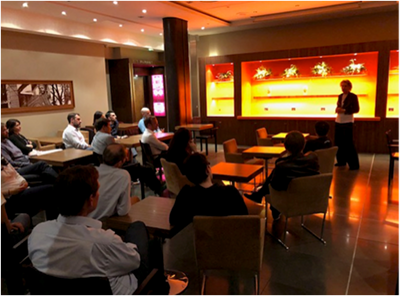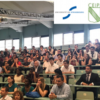Experience with IP design for medical technology at B. Braun: Dinner Speech at MIPLM in Strasbourg
B. Braun is one of the leading medical technology companies in Europe. With a revenue of around 6.1 bn euros, business activities in 65 countries and nearly 56,000 employees, the company is active in hospital care, surgical instruments, outpatient markets, and extracorporeal blood treatment. With trans care, it maintains activities in home healthcare services, and with Sterilog, the company works in the field of cleaning, decontamination, and sterilization of surgical instruments. In addition, B. Braun’s Aesculap division is a manufacturer of surgical equipment. B. Braun’s headquarters are located in the small town of Melsungen, in central Germany. The company was founded in 1939 and is still owned by the Braun family.
 Mrs. Solvey Fritsche from the IP department of B. Braun reported on her experience with IP design at B. Braun. She explained the approach to IP design, starting with the definition of the demand for IP and going on to the satisfaction of this demand by developing synthetic inventions. The IP strategy is aligned with the key aspects of the product for future customers in the medical market. The IP strategy is the starting point for developing prohibitive rights in such a way that they prevent the competition from being able to offer benefits which are perceived by the customer as being of equivalent value. This results in a sphere of exclusivity in the eyes of the customer, which allows B. Braun to integrate its value proposition into its value chain.
Mrs. Solvey Fritsche from the IP department of B. Braun reported on her experience with IP design at B. Braun. She explained the approach to IP design, starting with the definition of the demand for IP and going on to the satisfaction of this demand by developing synthetic inventions. The IP strategy is aligned with the key aspects of the product for future customers in the medical market. The IP strategy is the starting point for developing prohibitive rights in such a way that they prevent the competition from being able to offer benefits which are perceived by the customer as being of equivalent value. This results in a sphere of exclusivity in the eyes of the customer, which allows B. Braun to integrate its value proposition into its value chain.
 B. Braun now manages its IP within the scope of the business models and understands the importance of having a constant understanding of the evolving scenarios within competitive and market environments. This dynamic reality is taken into account in the problem-space/solution-space logic of the IP design process. This process integrates the required exclusivity along the value chain, the competitive environment, customer requirements, and technical possibilities, and helps to adjust the IP portfolio with the business model and continuous changes in the underlying circumstances.
B. Braun now manages its IP within the scope of the business models and understands the importance of having a constant understanding of the evolving scenarios within competitive and market environments. This dynamic reality is taken into account in the problem-space/solution-space logic of the IP design process. This process integrates the required exclusivity along the value chain, the competitive environment, customer requirements, and technical possibilities, and helps to adjust the IP portfolio with the business model and continuous changes in the underlying circumstances.
At the end of the IP design process, the identified invention environments must be translated into technologies, bearing in mind their intended benefit within the value chain and the intended customer benefit. In other words, the delivery must be translated into technological challenges and solutions. Potentially successful invention environments in terms of their contribution to the business model and potential patentability and enforceability, must be identified and evaluated. The invention core is isolated from these invention environments by discarding comparable or disruptive solutions described in the patent literature. This results in a patent portfolio which is closely aligned with the basic requirements of the IP strategy of B. Braun.



